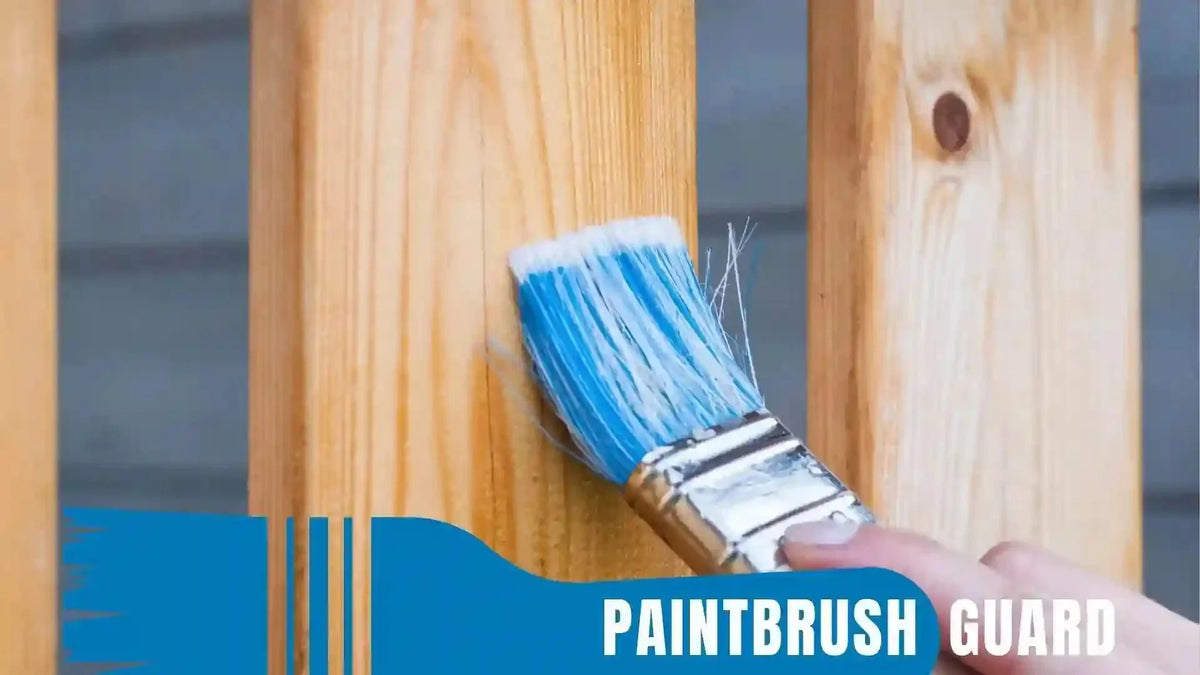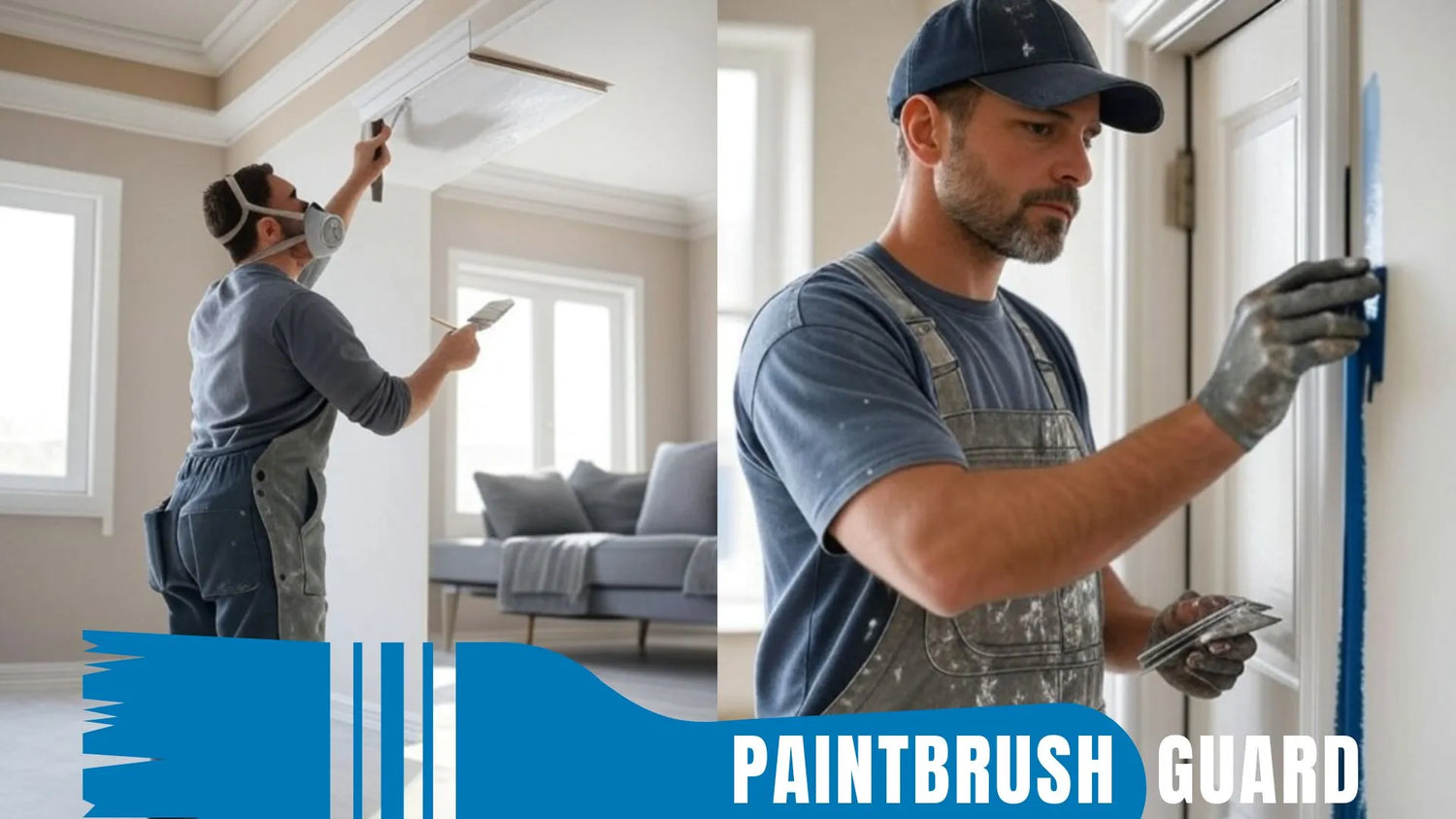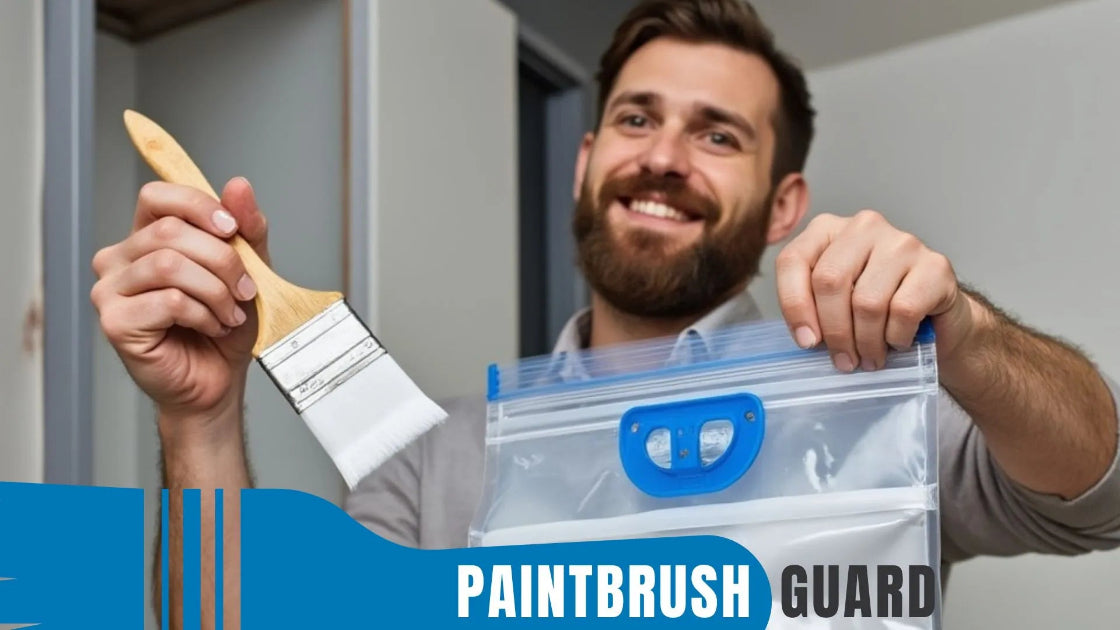
Ultimate Guide to Keeping Your Brushes Fresh and Functional
|
Time to read 18 min
|
Time to read 18 min
Paintbrushes are the backbone of any home painting project, and proper maintenance ensures they deliver a flawless finish while lasting through multiple jobs.
Neglecting brush care can lead to hardened bristles, fraying, or paint buildup, resulting in streaky applications and frequent replacements, which increase costs and waste. In 2025, tools like Paintbrush Guard have made brush maintenance more efficient and eco-friendly, saving time and resources.
This ultimate guide answers the top 20 questions about keeping paintbrushes fresh, soft, and functional, from preventing paint from drying to reducing wear.
Whether you’re a professional painter or a DIYer, these tips will help you maintain your brushes sustainably, ensuring they perform at their best for every project.
With no cleanup required after a painting session, you can take a short break mid-project or wrap up your painting for the day, your brush stays ready without the need to clean.
Keeping paint brushes fresh between coats is essential for maintaining a smooth workflow and achieving an even finish. The most effective method is to use Paintbrush Guard, which vacuum-seals the brush, keeping bristles wet for days.
After finishing a coat, seal the brush in the guard—no rinsing needed. For a 12x12 room taking 4–6 hours with 2–4 hours of drying between coats, this saves 15–30 minutes per break by skipping cleanup, ensuring the brush is ready for the next coat without drying out.
If Paintbrush Guard isn’t available, wrap the brush in plastic wrap or aluminum foil, then place it in a sealed plastic bag to trap moisture, keeping it fresh for up to 4 hours.
For longer intervals, store the wrapped brush in the freezer, thawing it for 30 minutes before use. These methods prevent paint from drying, maintaining the brush’s readiness and reducing water waste, making your painting process more sustainable.
Preventing brushes from getting hard starts with proactive care during and after use. The key is to keep paint from drying on the bristles—Paintbrush Guard excels here, vacuum-sealing the brush to keep it wet during breaks, preventing hardening for days. For a 12x12 room project, this saves 15–30 minutes per break, avoiding the need for intensive cleaning if paint dries.
If you don’t have Paintbrush Guard, wrap the brush in a damp cloth and place it in a sealed plastic bag during short breaks (1–2 hours), or freeze it for longer pauses, ensuring the paint stays wet. After painting, clean immediately—rinse latex paint with warm water and dish soap, or use mineral spirits for oil-based paint, taking 10–15 minutes.
Reshape the bristles and store flat. These steps, especially with Paintbrush Guard, keep bristles soft, preventing hardening and supporting eco-friendly practices by reducing the need for harsh solvents.
Learn more about Paintbrush Guard: This guide tackles the top 20 questions about storing paintbrushes, from quick breaks to long-term care, and even challenges like humid coastal areas.
Preventing paint from drying on your brush during breaks ensures it stays usable without intensive cleaning. Paintbrush Guard is the most efficient solution, vacuum-sealing the brush to keep bristles wet for days, eliminating the need to rinse between sessions.
Alternatively, wrap the brush tightly in plastic wrap or aluminum foil, then place it in a sealed plastic bag to retain moisture, effective for up to 4 hours. For longer breaks, store the wrapped brush in the freezer, thawing it for 30 minutes before use.
These methods prevent paint from drying, which can happen in as little as 1–2 hours, ensuring your brush remains soft and functional, minimizing waste and cleanup time.
Yes, Paintbrush Guard can effectively keep your brushes from hardening by using vacuum-seal technology to maintain wet bristles during breaks.
Paintbrush Guard prevents this by sealing the brush in an airtight environment, keeping the paint wet for days. This tool is especially useful for multi-coat projects, where drying times between coats (2–4 hours) can lead to hardening if the brush isn’t maintained.
By keeping bristles soft, Paintbrush Guard reduces the risk of damage from aggressive cleaning, extending brush life by up to 25%, per a 2023 Paint Quality Institute study.
Maintaining a paintbrush during a multi-day project ensures it stays functional without hardening or losing shape. Paintbrush Guard is the best tool for this, vacuum-sealing the brush to keep bristles wet for days, eliminating the need to clean between sessions.
For a 1,500-square-foot house interior taking 20–40 hours over several days, this saves 15–30 minutes per break, keeping the brush ready and reducing water waste, a sustainable practice.
Without Paintbrush Guard, wrap the brush in plastic wrap and store it in a sealed plastic bag, or freeze it overnight, thawing for 30 minutes before use. After each day’s work, clean minimally if needed—rinse latex paint with water and soap, or use a small amount of mineral spirits for oil-based paint, taking 10–15 minutes.
Reshape the bristles and store flat in a cool, dry place. These steps ensure your brush remains soft and effective throughout the project, minimizing environmental impact.
Painting interior walls? Our 10-step beginner guide with product recommendations ensures a flawless, professional finish for any room.
Keeping paint brushes soft involves preventing paint from drying and maintaining bristle condition. Paintbrush Guard is the best way to achieve this, vacuum-sealing the brush to keep bristles wet during breaks, ensuring they stay soft for days.
For a 12x12 room project, this saves 15–30 minutes per break, preventing the need for aggressive cleaning that can damage bristles, and reducing water use, aligning with sustainable practices.
After use, clean thoroughly—rinse latex paint with warm water and dish soap, or use mineral spirits for oil-based paint, taking 10–15 minutes. Then, condition the bristles with a lanolin-based brush conditioner, working it in and wiping off excess, which keeps natural bristles hydrated. Reshape and store flat.
Regular conditioning, paired with Paintbrush Guard’s ability to prevent drying, ensures bristles remain soft, extending brush life by up to 25% and reducing the need for replacements, a key eco-friendly benefit.
Preventing bristles from fraying requires careful use and maintenance to avoid undue stress. Start by using the right brush—synthetic for latex paint, natural for oil-based—to ensure bristles aren’t damaged by incompatible paint types.
Avoid pressing too hard while painting, as excessive pressure can cause bristles to bend and fray, especially on rough surfaces like textured walls, which might take 45–60 minutes to cut in for a 12x12 room.
Clean gently after use, using warm water and dish soap for latex paint or mineral spirits for oil-based paint, taking 10–15 minutes, and avoid soaking too long (under 30 minutes), as it can loosen the ferrule, leading to fraying.
Paintbrush Guard helps by keeping bristles wet during breaks, saving 15–30 minutes per session and reducing the need for aggressive cleaning, which can fray bristles. Store flat in a protective sleeve to maintain bristle alignment, ensuring long-term durability and sustainability.
Learn more about Paintbrush Guard: This guide tackles the top 20 questions about storing paintbrushes, from quick breaks to long-term care, and even challenges like humid coastal areas.
Paintbrush Guard revolutionizes brush maintenance by keeping bristles wet and ready, simplifying care and enhancing sustainability. Its vacuum-seal technology prevents paint from drying on the brush for days, eliminating the need to clean between sessions.
By preventing hardening, Paintbrush Guard reduces the need for aggressive cleaning, which can damage bristles and shorten brush life. A 2023 Paint Quality Institute study found that well-maintained brushes last up to 25% longer, and Paintbrush Guard supports this by preserving bristle softness and shape.
It also minimizes chemical use, as you can skip solvents like mineral spirits during breaks, reducing environmental impact. Paintbrush Guard ensures your brush is always ready, making maintenance effortless and sustainable for both pros and DIYers.
Paint in the ferrule—the metal band holding the bristles—can harden and cause bristles to splay, ruining the brush. To stop paint from getting into the ferrule, dip the brush only halfway into the paint, ensuring the paint line stays below the ferrule, and tap off excess on the can’s rim.
While painting, wipe the brush on a cloth frequently to remove excess paint, especially during detailed work like trim, which might take 1–2 hours for a 12x12 room.
If paint does reach the ferrule, clean immediately after use—rinse latex paint with warm water and soap, or use mineral spirits for oil-based paint, focusing on the ferrule with a brush comb, taking 10–15 minutes.
Paintbrush Guard prevents paint from drying in the ferrule during breaks, saving 15–30 minutes per session and reducing the risk of buildup, ensuring your brush stays functional and supporting a more sustainable maintenance routine.
Discover the best budget interior paint sprayers for 2025! Our detailed guide reviews the top 3 affordable interior paint sprayers for house interior painting.
Maintaining a paintbrush’s shape ensures it performs consistently for precise tasks like cutting in or trim work. The best way is to clean the brush thoroughly after each use—rinse latex paint with warm water and dish soap, or use mineral spirits for oil-based paint, taking 10–15 minutes.
Use a brush comb to remove residue, then reshape the bristles with your fingers while they’re wet, ensuring they align properly.
Store the brush flat or hang it by the handle, using its original packaging or a cardboard sleeve to hold the shape. Avoid storing upright on the bristles, as this can cause bending.
Paintbrush Guard helps during projects by keeping bristles wet, saving 15–30 minutes per break and preventing paint from drying, which can distort the shape. For a 12x12 room project, this ensures your brush retains its shape for clean lines, reducing waste by extending its usability sustainably.
Bristles falling out can ruin a paint job, leaving hairs in the finish, and is often caused by poor brush quality or improper care. Start with a high-quality brush—check that the ferrule is securely attached with no gaps, as loose ferrules allow bristles to shed.
Brands like Purdy and Wooster are known for durability, with bristles less likely to fall out, even after 20–40 hours on a 1,500-square-foot project.
Avoid soaking the brush for too long (under 30 minutes), as prolonged exposure to water or solvent can loosen the glue in the ferrule, causing bristle loss. Clean gently with warm water and soap for latex paint, or mineral spirits for oil-based paint, taking 10–15 minutes.
Paintbrush Guard reduces bristle stress by keeping the brush wet during breaks, saving 15–30 minutes per session and minimizing cleaning, ensuring the ferrule stays intact and bristles remain secure, a sustainable way to maintain your brush.
If you are planning to paint your house interior, in this article you will learn easy steps to make your home interior feel new again with step-by-step guides for all interior surfaces.
Keeping your paintbrush from drying out overnight is crucial for multi-day projects, ensuring it’s ready for use without cleaning.
Paintbrush Guard is the best solution, vacuum-sealing the brush to keep bristles wet for days, preventing paint from drying overnight. For a 1,500-square-foot house interior taking 20–40 hours over several days, this saves 15–30 minutes per break, reducing water and solvent use.
Without Paintbrush Guard, wrap the brush tightly in plastic wrap or aluminum foil, then place it in a sealed plastic bag to retain moisture, effective for up to 12 hours. Alternatively, store the wrapped brush in the freezer, thawing for 30 minutes before use.
These methods keep the paint wet, preventing drying that can occur in 1–2 hours, ensuring your brush stays soft and functional, minimizing cleanup and environmental impact.
Yes, you can use Paintbrush Guard to avoid cleaning brushes during breaks, streamlining your painting process. Its vacuum-seal technology keeps bristles wet for days, preventing paint from drying, so you can pause a project without rinsing.
For a 12x12 room with 2–4 hours between coats, this saves 15–30 minutes per break, as you can resume painting immediately, reducing water and solvent use, a key eco-friendly benefit.
While Paintbrush Guard eliminates cleaning during breaks, you should still clean the brush thoroughly after completing your project—rinse latex paint with warm water and soap, or use mineral spirits for oil-based paint, taking 10–15 minutes—to prevent long-term buildup.
By minimizing cleaning sessions, Paintbrush Guard reduces wear on the brush, extending its life by up to 25%, per a 2023 study, and supports sustainable painting by cutting down on resource use, making it ideal for both pros and DIYers.
In this exterior house painting guide you will learn how to prepare and paint all exterior surfaces step-by-step.
Maintaining a paintbrush for long-term use involves consistent care to preserve its condition. Clean thoroughly after each use—rinse latex paint with warm water and dish soap, or use mineral spirits for oil-based paint, taking 10–15 minutes.
Condition the bristles with a lanolin-based conditioner every few uses, working it in and wiping off excess to keep natural bristles hydrated, preventing brittleness.
Store the brush flat or hang it by the handle in a cool, dry place, using its original packaging to maintain shape, avoiding heat and humidity that can dry out bristles. During projects, Paintbrush Guard keeps the brush wet, saving 15–30 minutes per break and preventing hardening, reducing wear over time.
For a brush used in a 1,500-square-foot project (20–40 hours), these steps ensure it lasts for years, reducing replacements and waste, aligning with sustainable practices in 2025.
Preventing paint buildup on brushes ensures they remain effective and easy to clean. Dip the brush only halfway into the paint, keeping the paint line below the ferrule, and tap off excess on the can’s rim to avoid overloading.
Wipe the brush on a cloth frequently while painting, especially during detailed work like trim, which might take 1–2 hours for a 12x12 room, to remove excess paint before it accumulates.
Clean immediately after use—rinse latex paint with warm water and soap, or use mineral spirits for oil-based paint, focusing on the ferrule with a brush comb, taking 10–15 minutes.
Paintbrush Guard prevents buildup during breaks by keeping bristles wet, saving 15–30 minutes per session and reducing the need for aggressive cleaning, which can lead to buildup if paint dries. This method ensures your brush stays clean and functional, minimizing waste sustainably.
Paintbrush Guard Benefits: Learn more about the benefits of Paintbrush Guard vacuum storage. Save time, reduce water waste, prevent chemical pollution and cut costs on supplies for house painting projects.
Keeping your paintbrush from getting stiff requires preventing paint from drying and maintaining bristle flexibility. Paintbrush Guard is the most effective tool, vacuum-sealing the brush to keep bristles wet for days, preventing paint from drying and stiffening.
For a 12x12 room project, this saves 15–30 minutes per break, ensuring bristles stay soft without the need for soaking or harsh cleaning, reducing water use.
Clean promptly after use—rinse latex paint with warm water and dish soap, or use mineral spirits for oil-based paint, taking 10–15 minutes. Condition the bristles with a lanolin-based conditioner every few uses to keep them pliable, and store flat in a protective sleeve.
These steps, paired with Paintbrush Guard’s ability to prevent drying, keep your brush from getting stiff, extending its life and supporting eco-friendly painting practices by minimizing resource use.
Maintaining a paintbrush for oil-based paints requires careful cleaning and storage to handle the solvent-based formula. During breaks, use Paintbrush Guard to keep the brush wet, vacuum-sealing it to prevent paint from drying for days, saving 15–30 minutes per session for a 12x12 room project (4–6 hours). This reduces the need for solvents like mineral spirits, minimizing environmental impact, a key concern in 2025.
After use, clean with mineral spirits in a well-ventilated area, swirling the brush for 1–2 minutes, then wash with warm water and dish soap to remove residue, taking 15–20 minutes.
Condition natural bristles with a lanolin-based conditioner to prevent brittleness, and store flat in a cool, dry place. Avoid soaking in water, as it can swell the bristles, causing damage. These steps ensure your brush remains functional for oil-based paints, reducing waste by extending its lifespan sustainably.
This guide showcases the top 8 gray paint colors, available on Amazon, selected based on current popularity, including favorites like Agreeable Gray.
Daily paintbrush care ensures it stays in top condition during active projects. During breaks, use Paintbrush Guard to keep the brush wet, vacuum-sealing it to prevent paint from drying, saving 15–30 minutes per session for a 12x12 room project. This minimizes cleanup and preserves bristle softness, reducing water and solvent use, aligning with sustainable practices.
At the end of each day, clean minimally if continuing the next day—wipe excess paint with a cloth, then rinse latex paint with warm water and soap, or use a small amount of mineral spirits for oil-based paint, taking 10–15 minutes.
Reshape the bristles and store flat or in Paintbrush Guard overnight. Condition the bristles weekly with a lanolin-based conditioner to maintain flexibility. This daily routine ensures your brush remains ready and functional, minimizing wear and environmental impact over time.
Splaying occurs when bristles spread out, losing their shape and precision, often due to improper use or cleaning. To keep bristles from splaying, dip the brush only halfway into the paint, avoiding the ferrule, and tap off excess to prevent overloading.
Use light pressure while painting, especially on detailed work like trim, which might take 1–2 hours for a 12x12 room, to avoid bending the bristles.
Clean gently after use—rinse latex paint with warm water and soap, or use mineral spirits for oil-based paint, taking 10–15 minutes, and avoid soaking too long, as it can loosen the ferrule, causing splaying.
Paintbrush Guard prevents splaying by keeping bristles wet during breaks, saving 15–30 minutes per session and reducing the need for aggressive cleaning. Store flat in a protective sleeve to maintain bristle alignment, ensuring long-term precision and sustainability.
Find the 7 best green paint colors for your interior walls with our top picks. Learn about paint finnish, the natural vibe and rooms to apply for perfection.
Paintbrush Guard reduces brush wear by minimizing the stress that leads to bristle damage, ferrule loosening, and splaying. Its vacuum-seal technology keeps bristles wet during breaks, preventing paint from drying and hardening, which can require aggressive cleaning that wears down bristles.
For a 12x12 room project, this saves 15–30 minutes per break, reducing the frequency of cleaning sessions that can degrade the brush over time.
By skipping cleanup, Paintbrush Guard also reduces exposure to water or solvents that can loosen the ferrule or fray bristles, extending brush life by up to 25%, per a 2023 Paint Quality Institute study.
It minimizes chemical use, supporting eco-friendly practices by cutting down on solvents like mineral spirits, which contribute to environmental harm. Paintbrush Guard ensures your brush remains in top condition, reducing wear and replacements, making it a sustainable choice for painters.
Maintaining your paintbrushes is key to achieving professional-quality results while embracing sustainability in your home painting projects. From keeping brushes fresh between coats to preventing splaying, this guide has answered the top 20 questions about paintbrush care, highlighting tools like
Paintbrush Guard that save time (15–30 minutes per break) and reduce wear. As of 2025, Paintbrush Guard has become essential for painters, cutting down on water and chemical use while extending brush life by up to 25%.
Whether you’re a pro tackling a 1,500-square-foot house or a DIYer painting a room, these techniques ensure your brushes stay soft, functional, and ready for every project.
By using Paintbrush Guard and adopting these maintenance practices, you’ll minimize waste, save resources, and achieve flawless finishes, transforming your home sustainably, one stroke at a time.
Paintbrush Guard uses vacuum-seal technology to create an airtight environment, preventing paint from drying on bristles for days during short-term breaks or even months for long-term storage. For a 12x12 room project with 2–4 hours between coats, it saves 15–30 minutes per break by eliminating cleaning, keeping brushes ready for immediate use and maintaining their condition sustainably.
Yes, Paintbrush Guard replaces the need for wrapping brushes in plastic wrap, damp cloths, or freezing by vacuum-sealing them for both short-term (hours to days) and long-term (weeks to months) storage. This ensures bristles stay wet and soft without additional solutions, reducing water and solvent use for eco-friendly painting.
By vacuum-sealing brushes, Paintbrush Guard prevents air exposure, stopping paint from drying and hardening in as little as 1–2 hours. For a 1,500-square-foot project, it saves 15–30 minutes per break, keeping bristles pliable and eliminating cleaning, ensuring brushes remain functional and supporting sustainable practices by minimizing resource waste.
Paintbrush Guard eliminates cleaning between sessions, saving 1–2 gallons of water per project and reducing solvent use for oil-based paints. Its reusable bags and ability to extend brush life by up to 25% (per a 2023 Paint Quality Institute study) minimize waste, making it a key eco-friendly tool for both short-term and long-term brush storage.
Paintbrush Guard keeps bristles wet and protected during short-term and long-term storage, preventing paint buildup and reducing the need for aggressive cleaning that can fray bristles or loosen the ferrule. This ensures brushes maintain their shape for precise tasks like trim work, saving time and extending durability for projects like a 12x12 room or larger.

Learn about eco-friendly painting, tips and tutorials on house interior and exterior surfaces, so you can get started with your project without any surprices during or after your painting.

Learn how interior house paint colors influence mood with expert tips on room preference so you can pick the best colors for a harmonious home environment.
We focus on the most popular shades for each interior colors, so you don't miss no matter what color you pick.

Learn how this innovative tool allows you to store paintbrushes without the need for immediate cleaning, offering significant advantages in time savings, water conservation, reduced chemical pollution, and lower costs for supplies.

